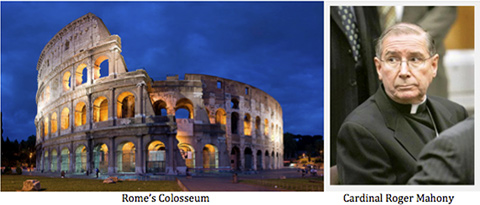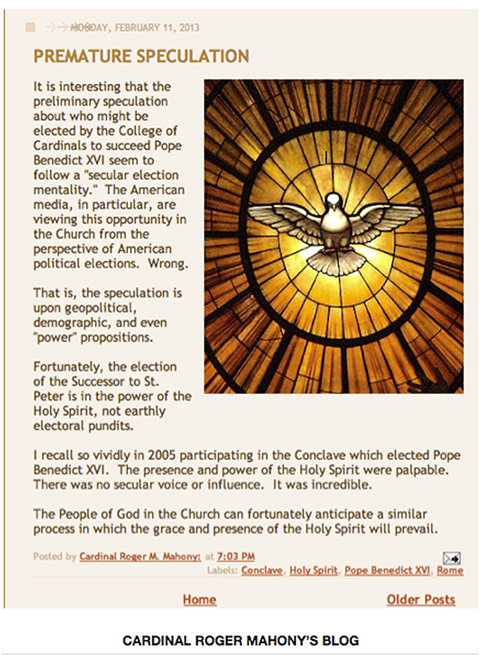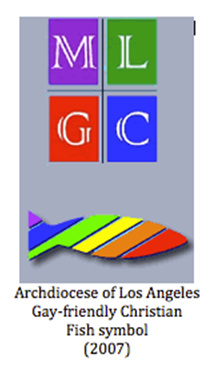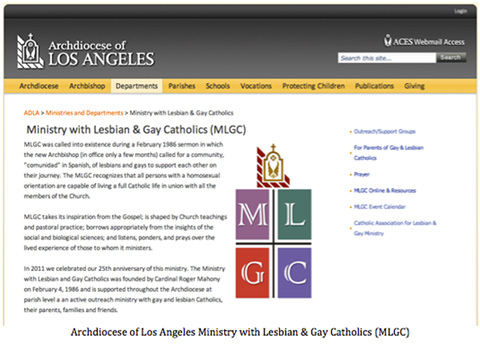Cardinal Roger Mahony's reign of terror--and why he should not board that plane for Rome
By
Marielena Montesino de StuartRome is an ancient city with a peculiar way of showing distaste for cowards, liars and thieves. It has a history of not treating them well.

The moment of electing a Pope, by modernist Roman Catholic standards, is fast approaching. The process, known as a "Conclave," from the Latin
cum clave ("with a key") used to involve locking the College of Cardinals inside the Sistine Chapel, until they reached a decision. Pursuant to the Apostolic Constitution
Universi Dominici Gregis issued by Pope John Paul II, the Cardinals are no longer locked throughout the process. Now, the Vatican has announced that Benedict XVI may write a
Motu Propio (a personal document which has the full force of Church law ? and which addresses a specific issue) in order to make additional changes to the Conclave process. In such document he may "harmonize" the
Universi Dominici Gregis with the
Ordo Rituum Conclavis" (Rites of the Conclave).
But the most important "harmony" that is needed is a clean-up of the corrupt element inside the College of Cardinals ? and the modernist hierarchy of the Roman Catholic Church, which has abandoned tradition and has violated most of the Ten Commandments ? particularly the sixth and the seventh, as pertains to the clergy.
Case in point: a Pope cannot be legitimately chosen with Cardinal Mahony inside the upcoming Conclave. Imagine the scenario ? where a Pope squeaks by with a one vote margin ? and that margin is none other than the deciding vote of a corrupt human being and a disgrace to the Roman Catholic Church and to humanity ? such as Cardinal Roger Mahony, from the Archdiocese of Los Angeles.
The string of scandals involving Cardinals and Bishops ? and their cover-up of pederasty and other sexual abuses in the Catholic Church, keeps growing. Lately, the most noticeable (but certainly NOT the only one of these scandals) involves Cardinal Mahony.
While he was supposed to be guiding his flock, Mahony managed to build one of the most horrific records of cover-ups ever recorded, involving pederasty and other forms of sexual abuse. If the old cum clave process were still in place ? how would you like to be locked inside a room with Mahony? What if you were told that there is more than one Mahony in that room with you ? and that such corrupt individuals are being treated as worthy of electing a Pope? That is exactly what is about to happen.
The following report contains links to documents outlining some of the heinous sexual crimes committed against children in the Archdiocese of Los Angeles, during Mahony's reign. These records were released recently, pursuant to the order of a federal judge:
http://www.latimes.com/news/local/la-me-church-files-20130122,0,3114631.story
http://clergyfiles.la-archdiocese.org/listing.html
The Conclave has been accepted for hundreds of years in the tradition of the Catholic Church. But these days the Conclave should be cause for worry ? given the impostors that have entered the College of Cardinals. Historians report that in past centuries bribes, threats, poisons ? and even fist fights, broke out inside the Conclave. I wonder if this time a brave Cardinal will plant some well-deserved shiners on the impostors, as they enter the Sistine Chapel to cast their votes.
Cardinal Mahony's reign of terror
Cardinal Roger Mahony's reign of terror at the Archdiocese of Los Angeles began in 1985 ? and did not end until 2011. But his dark legacy and the crimes he covered up, will never be forgotten.
If Mahony boards a plane for Rome to be part of the Conclave ? he will do so as part of his long-standing defiance of countless victims of sexual abuse, as well as faithful Catholics ? who do not want him anywhere near Rome ? or a church, for that matter.
God never lies
These corrupt Cardinals who have participated in cover-ups ? ranging from pederasty to shady financial deals, are considered "untouchable." Instead of being expelled ? they are rewarded and protected. The incidence of moral turpitude in the College of Cardinals puts the entire Conclave on an illegitimate path. Why? Because God never lies. As such, God would never support a Church hierarchy that includes evil individuals who draw a veil over the sexual abuse of children and other immoral practices. You don't need to be a theologian or a philosopher to understand this truth. (Reference: http://www.renewamerica.com/columns/marielena/110508)
A step in the right direction?
The current Archbishop of Los Angeles, Jos? H. G?mez, publicly excoriated Mahony after a federal judge ordered the release of nauseating sexual abuse records and cover-ups. This excoriation appeared to be a step in the right direction ? but not for long:
ARCHBISHOP OF LOS ANGELES JOSE H. GOMEZ ? STATEMENT RE- CARDINAL MAHONY AND RELEASE OF SEXUAL ABUSE RECORDS ? JANUARY 31, 2013?2013-0131_JHGStatement-EN
Political grandstanding
The actions by Archbishop G?mez turned out to be nothing but political grandstanding, as evidenced by the following statement published on the Archdiocese of Los Angeles website, where Archbishop Gomez does an about-face ? and fully endorses Cardinal Mahony's participation in the upcoming Conclave:
ARCHBISHOP JOSE H. GOMEZ EXTENDS HIS WARM WISHES TO CARDINAL MAHONY ON HIS TRIP TO ROME TO PARTICIPATE IN THE CONCLAVE ? 2013-0215_Letter_to_priests-Conclave
Rampant dysfunction
As a former resident of Los Angeles, I lived through most of Cardinal Mahony's reign of terror. During my years in the Archdiocese of Los Angeles, the rampant dysfunction under Cardinal Mahony could be felt at every level. Yet, in spite of the countless objections from victims of Mahony's reign ? as well as from faithful Catholics in general, the Church administration (headed by Benedict XVI) is allowing Mahony to participate, once again, in the Conclave process.
Cardinal Mahony: master of disguise
Roger Mahony is a master of sly indirectness and Fabian strategy. He has used powerful lawyers and public relations experts to carry out tactics of attrition against victims of sexual abuse ? while assuming that time is on his side.
Part of Mahony's mastery of disguise is his ability to claim the presence of the Holy Spirit ? in order to carry out his schemes.
The following is a quote dated February 11, 2013 ? directly from Cardinal Mahony's blog (yes, this man has the nerve to run a blog!):
"PREMATURE SPECULATION"
"Fortunately, the election of the Successor to St. Peter is in the power of the Holy Spirit, not earthly electoral pundits."
"I recall so vividly in 2005 participating in the Conclave which elected Pope Benedict XVI. The presence and power of the Holy Spirit were palpable. There was no secular voice or influence. It was incredible."
"The People of God in the Church can fortunately anticipate a similar process in which the grace and presence of the Holy Spirit will prevail." ? Cardinal Roger Mahony
By invoking the presence of the Holy Spirit , Mahony tries to divert the reader's attention away from his own evil maneuvers. This manipulation of the faith and trust of well-meaning Catholics is absolutely repulsive. Mahony cannot be trusted. His track record of covering up crimes involving pederasty and other forms of sexual abuse, do not present a man in a state of grace. Mahony's resolve to cover up these crimes ? exposes a man incapable of acting in the best interest of Holy Mother Church and humanity.
 Hijacking the Holy Spirit
Hijacking the Holy SpiritThe seven gifts of the Holy Spirit, as enumerated in Isaiah 11:2-3, are present in their fullness in Jesus Christ ? and in Christians who are in a state of grace. These gifts are: wisdom, understanding, counsel, fortitude, knowledge, piety ? and fear of the Lord. A simple review of the Catechism will reinforce this.
Sadly, many Catholics never open the Catechism in these "modern" times. Instead, they have bought into the modernist approach of faith formation, which includes going on cruise ship seminars ? where they can have Catholicism poured into their heads ? while eating canap?s and drinking beer. For others, these cruises are a great place to harpoon a rich Catholic businessman, who may cut that next business deal ? while the Holy Spirit is hijacked in the high seas of modern Catholicism.
Catholicism is big business
To make matters worse, faithful Catholics need to be aware that Catholicism has turned into a big business ? particularly targeting conservative and traditional Catholics ? who are tired of the corruption in the Church hierarchy. Many Catholics claim to be "conservative" and "traditional" ? when they are selling a service or a product ? when in fact they may very well be 'breaking bread' with a corrupt Bishop, Cardinal or politician. Buyers and donors beware!
Cardinal Mahony and homosexuals

Mahony's intense involvement in bringing homosexuals into the Church was manifested in an unforgettable statement, where he appeared to justify spending large amounts of Church funds for an outreach program to Lesbians and Gays ?
"in order to bring their gifts, talents and experiences to enrich the local Church." This caused great consternation throughout the Archdiocese of Los Angeles. It was clear that the modernists in Rome were determined to impose their rules in every corner of the Roman Catholic world ? with shameless disregard for the most sacred Church doctrines and teachings ? essential for the proper formation of young Christian children. Cardinal Mahony has served Rome diligently, when it comes to institutionalizing the homosexual culture in the Roman Catholic Church.

Mahony apparently considers that his predilection for involving homosexuals in a ministry at the Archdiocese of Los Angeles ? is an act of the Holy Spirit. Mahony also appears to think that he can actually create a disconnection between the homosexual environment in the Archdiocese of Los Angeles ? and the incidence of pederasty.
But most of all ? Mahony forgets that some of us can tell an evil impostor from a holy person.
If my indignation and repulsion towards the actions of Cardinal Roger Mahony are so great ? I can imagine the deep pain and abandonment felt by victims of sexual abuse, at the hands of evil priests who enjoyed Mahony's protection.
Cardinal Mahony participated in the election of Benedict XVI ? and he is about to do it again
The current hierarchy of the Roman Catholic Church is in a state of collapse ? and Benedict XVI, who was in charge of it all ? has called it quits. One cannot help but question the legitimacy of Benedict XVI's election, considering the presence of the infamous Cardinal Bernard Law and Cardinal Roger Mahony ? and others similar to them ? during the 2005 Conclave. What if Cardinal Mahony and his ilk held the deciding votes in the Conclave of 2005? Under such circumstances ? how can anyone claim that the choice made was the act of the Holy Spirit? Benedict XVI's modernist approach of turning his back on the Throne of Peter, is a reflection of the modernist Conclave that elected him.
Confronting the reality of these modernist Conclaves and the corrupt element within, is fundamental for anyone who wants to stand in defense of Holy Mother Church and respect the Commandments of God.
They are monsters, they are dangerous and they are organized
The impostors that have entered the hierarchy of the Roman Catholic Church are monsters ? they are dangerous and they are organized. Those that choose to turn a blind eye to this horrific reality ? and ride the coattails of corrupt Bishops and Cardinals, must assume responsibility as collaborators.
Cardinal Mahony once told the press (referring to Cardinal Law's cover-up of pederasty and other forms of sexual abuse at the Archdiocese of Boston) ? that, "he would find it difficult to walk down an aisle in church if he had been guilty of gross negligence." Given Mahony's record of gross negligence, he needs to honor his statement ? and not walk into the Sistine Chapel.
As Christians we all know that when Christ returns the dead shall rise ? and in the case of Cardinal Mahony that will include the dead buried at the cemetery that he sacked ? by raiding their maintenance funds (with the Vatican's blessing) ? in order to pay for settlements of sexual abuse.
... which leads me to the final point:
Rome is not for cowards, liars and thieves
Rome is an ancient city with a peculiar way of showing distaste for cowards, liars and thieves. It has a history of not treating them well. This would make it very difficult for Mahony to get around.
But even worse, is Divine retribution, which can strike when you least expect it. After all, we already saw lightning strike St. Peter's Basilica shortly after Benedict XVI announced that he was turning his back on the Throne of Peter.
If I were Mahony, I would not take the risk of boarding that plane for Rome.
? Marielena Montesino de Stuart
Source: http://www.renewamerica.com/columns/marielena/130223
kenyon martin big miracle slab city super bowl snacks appleton







 By Kate Jackson
By Kate Jackson